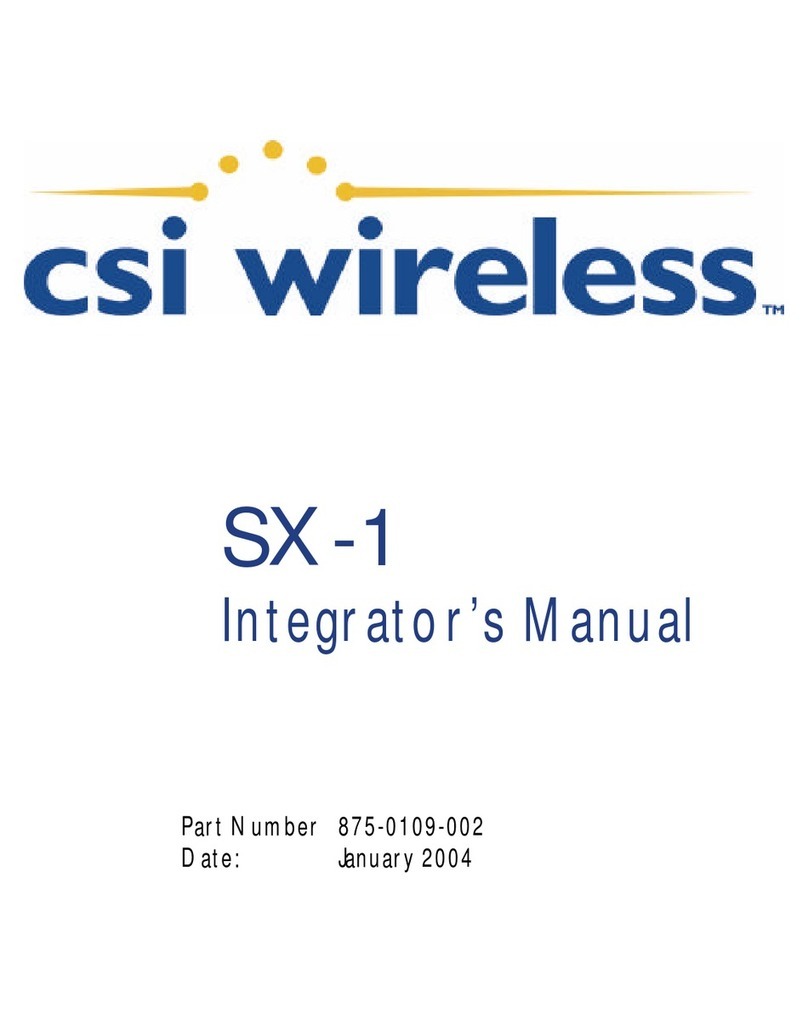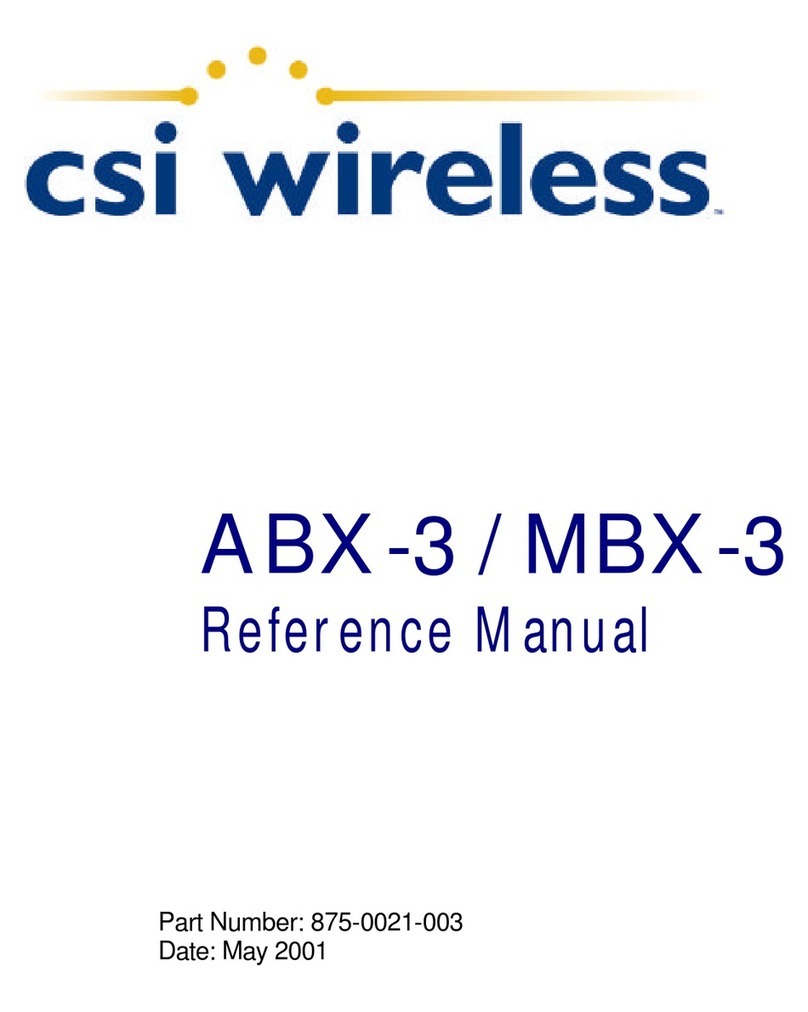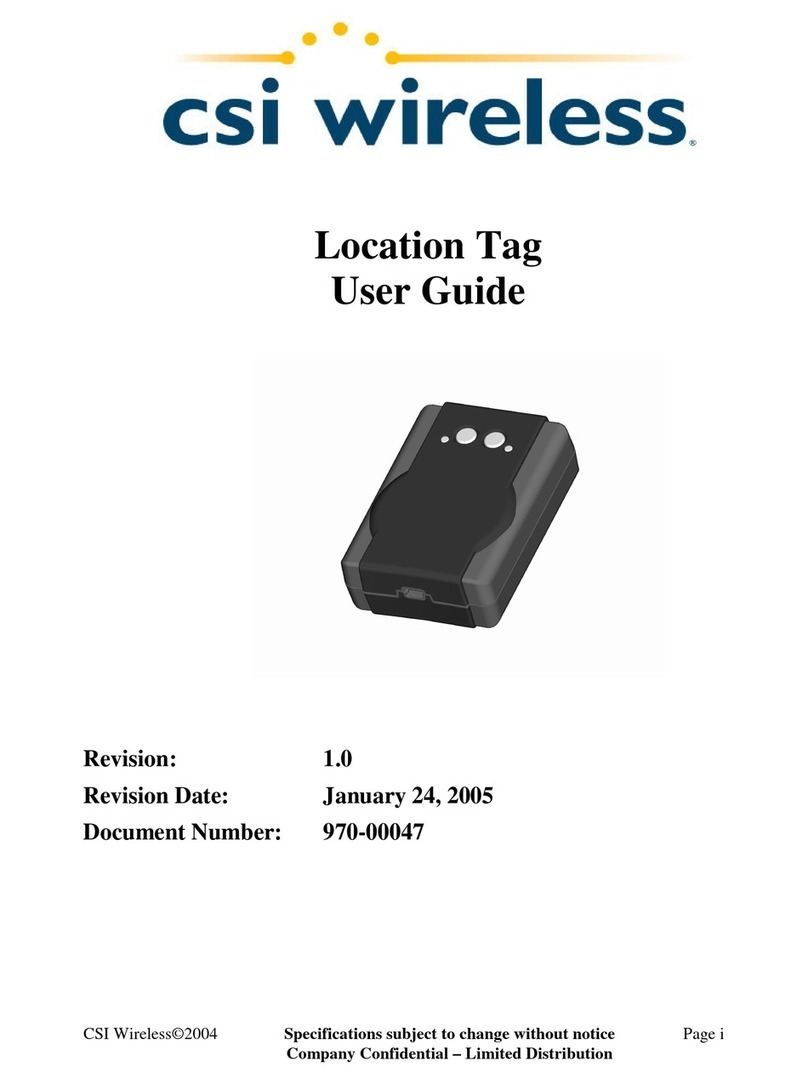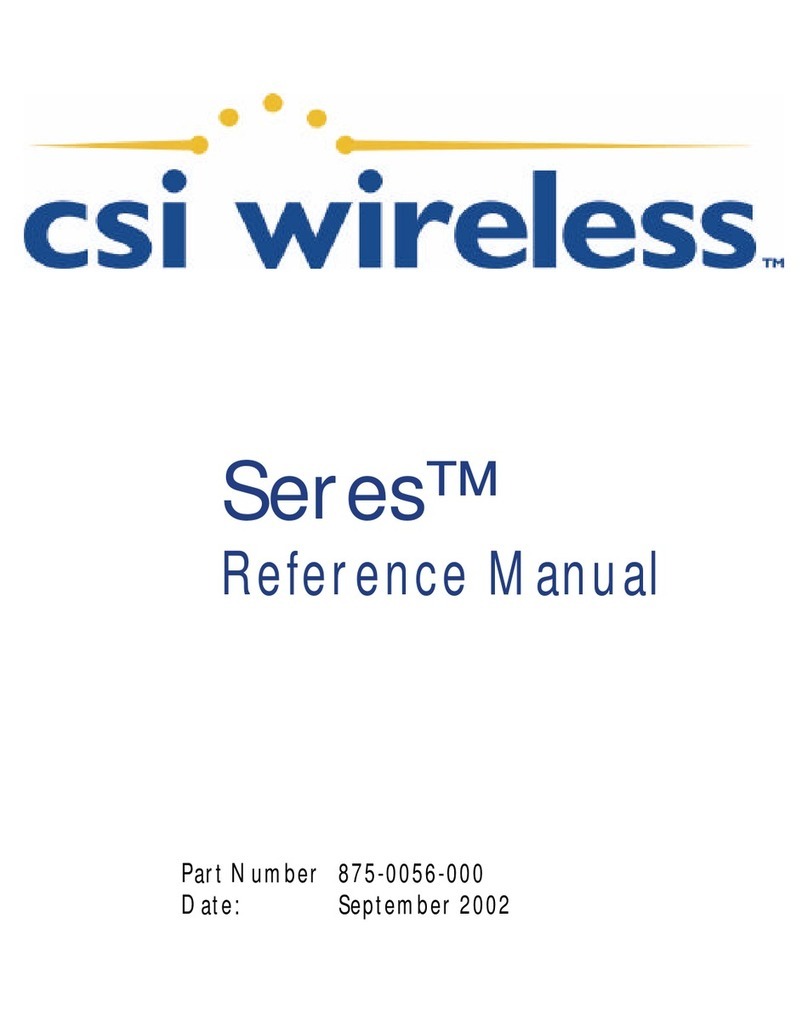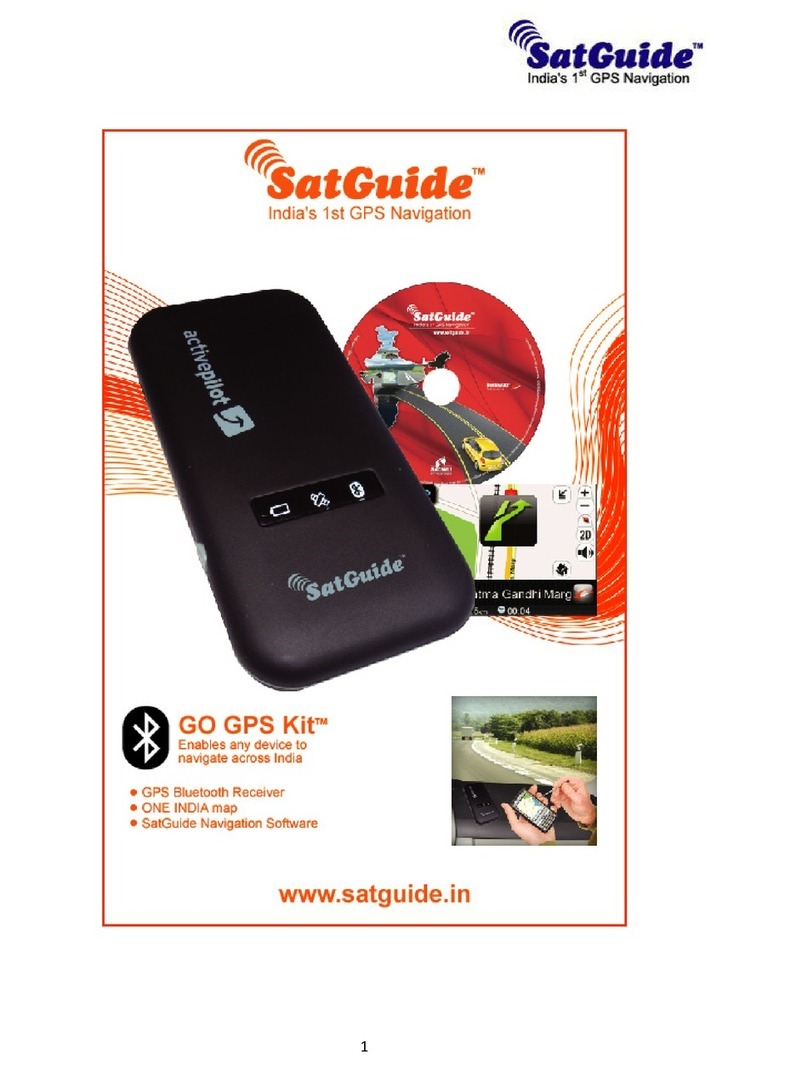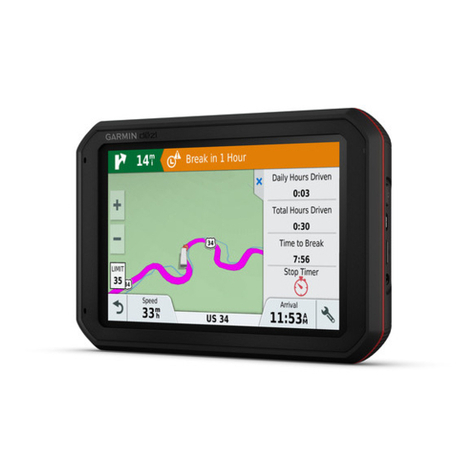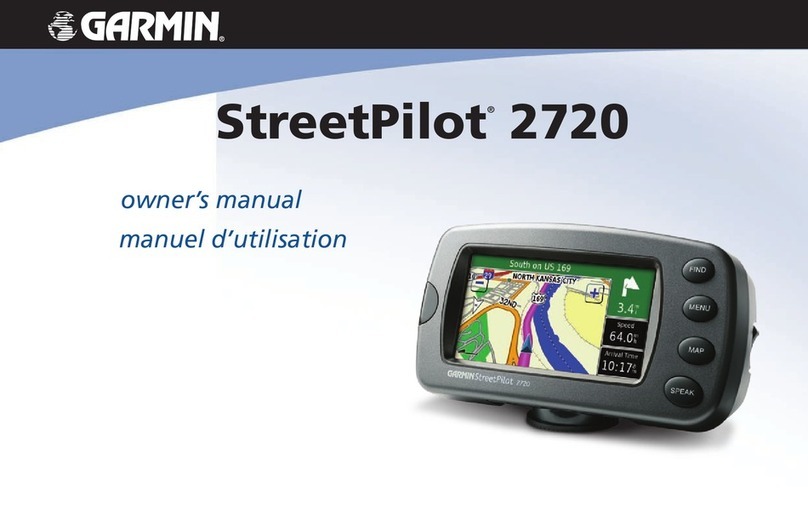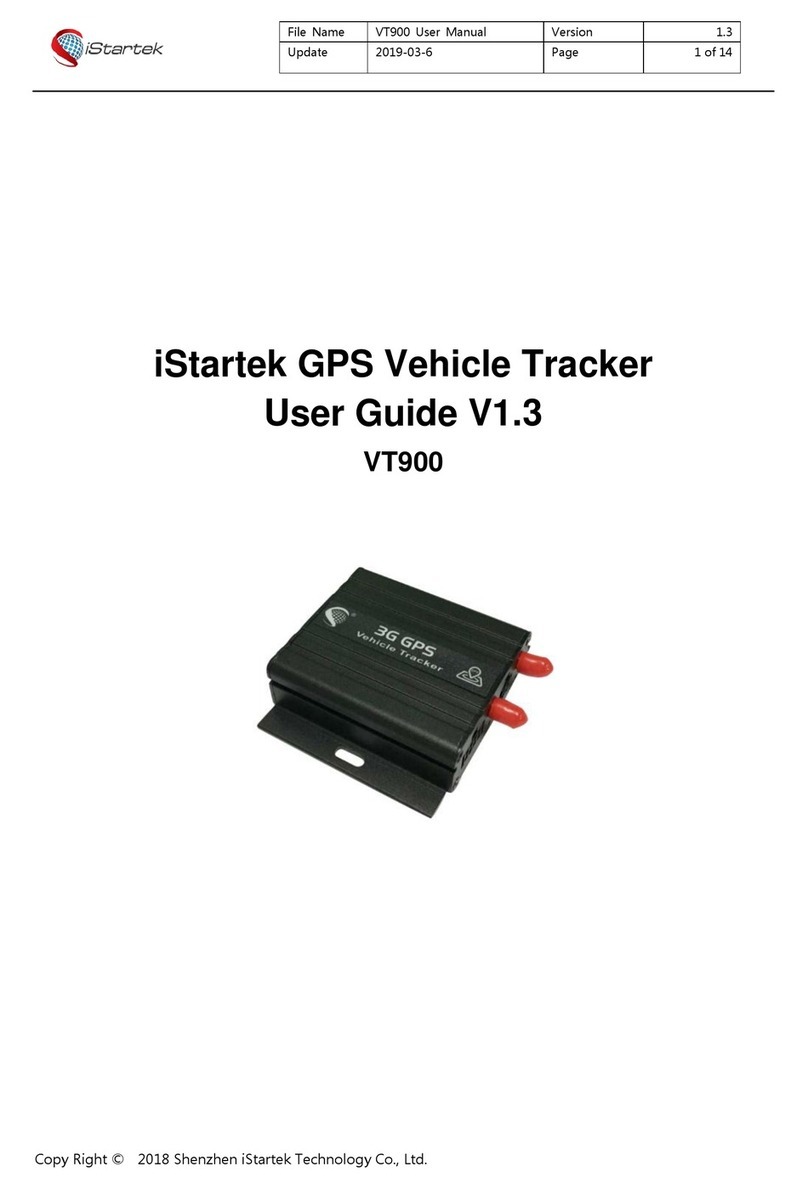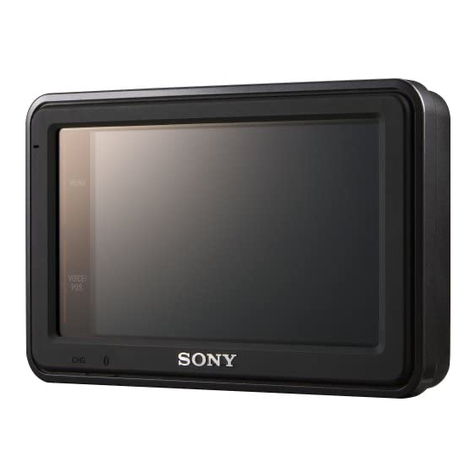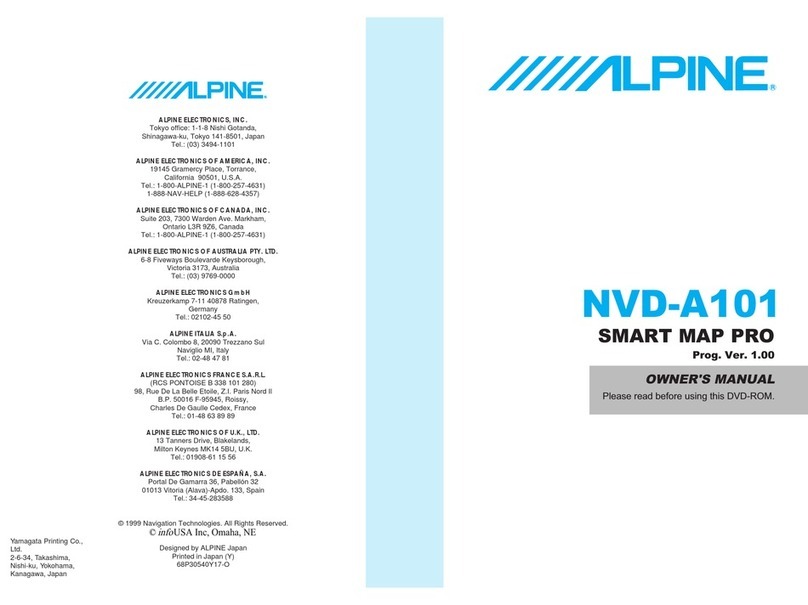CSI Wireless Vector Sensor User manual

Vector Sensor
Reference Manual
Part Number 875-0075-001
Date: March 2004

Vector Sensor Reference Manual ii
Copyright Notice
Copyright 2004 CSI Wireless Inc. All rights reserved. No part of this manual may be stored in
a retrieval system, transmitted, or reproduced by any means, including, but not limited to
photocopy, photograph, digitizing, or otherwise, without the prior written permission from CSI
Wireless Inc.
Trademarks
The CSI Wireless logo and COAST™ are trademarks of CSI Wireless Inc. All other trademarks
are the property of their respective owners.
FCC Notice
This device complies with Part 15 of the FCC Rules. Operation is subject to the following two
conditions.
(1) this device may not cause harmful interference, and
(2) this device must accept any interference received, including interference that may cause
undesired operation.
CSI Wireless Inc.
4110 9th Street SE
Calgary, Alberta, Canada T2G 3C4
Telephone number: +1-403-259-3311
Fax number: +1-403-259-8866
E-mail address: info@csi-wireless.com
Web Site: www.csi-wireless.com
CSI Wireless Limited Warranty
CSI Wireless Inc. (“CSI”) hereby warrants solely to the end purchaser of the Products, subject to
the exclusions and procedures set forth herein below, that the Products sold to such end
purchaser shall be free, under normal use and maintenance, from defects in material and
workmanship for a period of 12 months from delivery to such end purchaser. Repairs and
replacement components are warranted, subject to the exclusions and procedures set forth
below, to be free, under normal use and maintenance, from defects in material and workmanship
for 90 days from performance or delivery, or for the balance of the original warranty period,
whichever is greater.
Purchaser’s Exclusive Remedy

Vector Sensor Reference Manual iii
The end purchaser’s exclusive remedy under this warranty shall be limited to the repair or
replacement, at the option of CSI Wireless, of any defective Products or components thereof.
The end user shall notify CSI Wireless or a CSI Wireless approved service center immediately of
any claimed defect. Repairs shall be made through a CSI Wireless approved service center only.
Exclusions
CSI Wireless does not warrant damage occurring in transit or due to misuse, abuse, improper
installation, neglect, lightning (or other electrical discharge) or fresh/salt water immersion of
Products. Repair, modification or service of CSI Wireless products by any party other than a CSI
Wireless approved service center shall render this warranty null and void. CSI Wireless does not
warrant claims asserted after the end of the warranty period. CSI Wireless does not warrant or
guarantee the precision or accuracy of positions obtained when using Products. Products are not
intended for primary navigation or for use in safety of life applications. The potential accuracy of
Products as stated in CSI Wireless literature and/or Product specifications serves to provide only
an estimate of achievable accuracy based on:
•Specifications provided by the US Department of Defense for GPS Positioning,
•GPS OEM Receiver specifications of the appropriate manufacturer (if applicable), and
•DGPS service provider performance specifications.
CSI Wireless reserves the right to modify Products without any obligation to notify, supply or
install any improvements or alterations to existing Products.
No Other Warranties
THE FOREGOING WARRANTY IS EXCLUSIVE OF ALL OTHER WARRANTIES, WHETHER
WRITTEN, ORAL, IMPLIED OR ARISING BY STATUTE, COURSE OF DEALING OR TRADE
USAGE, IN CONNECTION WITH THE DESIGN, SALE, INSTALLATION, SERVICE OR USE OF
ANY PRODUCTS OR ANY COMPONENTS THEREOF, INCLUDING, BUT NOT LIMITED TO,
ANY WARRANTY OF MERCHANTABILITY OR FITNESS FOR A PARTICULAR PURPOSE.
Limitation of Liability
THE EXTENT OF CSI WIRELESS’S LIABILITY FOR DAMAGES OF ANY NATURE TO THE END
PURCHASER OR ANY OTHER PERSON OR ENTITY WHETHER IN CONTRACT OR TORT
AND WHETHER TO PERSONS OR PROPERTY SHALL IN NO CASE EXCEED, IN THE
AGGREGATE, THE COST OF CORRECTING THE DEFECT IN THE PRODUCT OR, AT CSI
WIRELESS’S OPTION, THE COST OF REPLACING THE DEFECTIVE ITEM. IN NO EVENT
WILL CSI WIRELESS BE LIABLE FOR ANY LOSS OF PRODUCTION, LOSS OF PROFITS, LOSS
OF USE OR FOR ANY SPECIAL, INDIRECT, INCIDENTAL, CONSEQUENTIAL OR
CONTINGENT DAMAGES, EVEN IF CSI WIRELESS HAS BEEN ADVISED OF THE POSSIBILITY
OF SUCH DAMAGES. WITHOUT LIMITING THE FOREGOING, CSI WIRELESS SHALL NOT
BE LIABLE FOR ANY DAMAGES OF ANY KIND RESULTING FROM INSTALLATION, USE,
QUALITY, PERFORMANCE OR ACCURACY OF ANY PRODUCTS.

Vector Sensor Reference Manual iv
Governing Legislation
To the greatest extent possible, this warranty shall be governed by the laws of the State of Arizona.
In the event that any provision hereof is held to be invalid by a court of competent jurisdiction,
such provision shall be severed from this warranty and the remaining provisions shall remain in full
force and effect.
Obtaining Warranty Service
In order to obtain warranty service, the end purchaser must bring the Product to a CSI Wireless
approved dealer, along with the end purchaser’s proof of purchase. For any questions regarding
warranty service or to obtain information regarding the location of any of CSI Wireless’s dealers,
contact CSI Wireless at the following address.
CSI Wireless Inc.
4110 9th Street SE
Calgary AB, T2G 3C4
Canada
Telephone number: +1-403-259-3311
Fax number: +1-403-259-8866
E-mail address: techsupport@csi-wireless.com

Vector Sensor Reference Manual v
Table of Contents
List of Figures..............................................................................................................................xi
List of Tables..............................................................................................................................xii
Preface ......................................................................................................................................xiv
Organization ....................................................................................................................xv
Customer Service............................................................................................................xv
World Wide Web Site.................................................................................................xvi
Document Conventions................................................................................................xvi
Notes, Cautions, and Warnings..................................................................................xvi
1. Quick Start..................................................................................................................17
1.1 Receiving Your Shipment...................................................................................17
1.2 Unpacking Your Vector Sensor System...........................................................17
1.3 Cable Connections..............................................................................................18
1.4 Understanding the Vector Sensor....................................................................18
1.4.1 Moving Base Station RTK.....................................................................19
1.4.2 Supplemental Sensors -Reduced Search Time................................19
1.4.3 Supplemental Sensors -Heading System Backup.............................19
1.5 Installation Overview..........................................................................................20
1.6 Mounting Configurations and Offset Settings.................................................21
1.7 Gyro Initialization Process.................................................................................21
1.8 NMEA 0183 Message Interface.........................................................................22
1.8.1 Tilt Aiding...............................................................................................22
1.8.2 Tilt Sensor Calibration..........................................................................22
1.8.3 Magnetic Aiding.....................................................................................22
1.8.4 Magnetometer Calibration ...................................................................23
1.8.5 Gyro Aiding............................................................................................24
1.8.6 Time Constants......................................................................................25
1.8.7 Level Operation .....................................................................................28
1.8.8 Heading Compensation ........................................................................28
1.8.9 Configuring for Pitch or Roll...............................................................29
1.8.10 Configuring Negative Pitch or Roll....................................................29
1.8.11 Pitch / Roll Compensation...................................................................30
1.8.12 Forcing a New RTK Search.................................................................31
1.8.13 Antenna Separation...............................................................................31

Vector Sensor Reference Manual vi
1.8.14 Summary Command..............................................................................32
1.8.15 HELP command......................................................................................32
1.8.16 $HEHDT Message..................................................................................33
1.8.17 $HEROT Message..................................................................................33
1.8.18 Proprietary $PSAT,INTLT Message....................................................33
1.8.19 Proprietary $PSAT,HPR Message.......................................................34
2. Installation...................................................................................................................35
2.1 System Parts List..................................................................................................35
2.2 Cable Interface.....................................................................................................35
2.3 Vector Antenna Array Placement....................................................................36
2.3.1 MBL-3 Placement and Beacon Reception..........................................36
2.4 Environmental Considerations..........................................................................37
2.5 Power Considerations.........................................................................................37
2.6 Electrical Isolation................................................................................................37
2.7 Vector Antenna Array Mounting......................................................................37
2.7.1 Magnetic Mounting (Optional Accessory)........................................38
2.7.2 Pole and Rail Mounting........................................................................38
2.7.3 Routing and Securing the Antenna Cable........................................39
2.7.4 Connecting the CDA-RTK and MBL-3 Antennas...........................40
2.7.5 Powering the Vector Sensor................................................................40
2.7.6 Turning the Vector Sensor On...........................................................41
2.7.7 Connecting the Vector Sensor To External Devices......................41
2.8 LED Indicators......................................................................................................43
3. Overview.....................................................................................................................45
3.1 GPS.........................................................................................................................45
3.1.1 Satellite Tracking....................................................................................45
3.1.2 Positioning Accuracy............................................................................45
3.1.3 Update Rates..........................................................................................46
3.2 SBAS.......................................................................................................................46
3.2.1 Automatic Tracking...............................................................................46
3.2.2 SBAS Performance.................................................................................46
3.3 Beacon Operation ...............................................................................................47
3.3.1 Tune Modes............................................................................................47
3.3.2 Receiver Performance...........................................................................49
3.4 COAST™ Technology.......................................................................................50
3.5 Default Parameters..............................................................................................50
3.6 Vector Sensor Architecture...............................................................................52

Vector Sensor Reference Manual vii
3.6.1 GPS Hardware........................................................................................52
3.6.2 GPS Firmware.........................................................................................52
3.6.3 GPS Applications...................................................................................52
3.6.4 Beacon Firmware...................................................................................53
4. Operation....................................................................................................................54
4.1 Powering the Vector Sensor..............................................................................54
4.2 Communicating with the Vector Sensor.........................................................54
4.2.1 NMEA 0183 Interface...........................................................................54
4.2.2 Binary Interface......................................................................................55
4.2.3 RTCM SC-104 Protocol.......................................................................55
4.3 Configuring the Vector Sensor..........................................................................56
4.4 Configuring the Data Message Output............................................................56
4.4.1 This Port and the Other Port.............................................................57
5. PocketMAX Utility.....................................................................................................58
6. NMEA 0183 Messages..............................................................................................60
6.1 NMEA Message Elements...................................................................................60
6.2 PocketMAX...........................................................................................................60
6.3 General Commands............................................................................................61
6.3.1 $JASC,D1................................................................................................62
6.3.2 $JAIR........................................................................................................63
6.3.3 $JASC,VIRTUAL.....................................................................................63
6.3.4 $JALT .......................................................................................................64
6.3.5 $JLIMIT.....................................................................................................65
6.3.6 $JAPP.......................................................................................................65
6.3.7 $JBAUD...................................................................................................66
6.3.8 $JCONN..................................................................................................66
6.3.9 $JDIFF.......................................................................................................67
6.3.10 $JK............................................................................................................67
6.3.11 $JPOS.......................................................................................................68
6.3.12 $JQUERY,GUIDE...................................................................................68
6.3.13 $JRESET...................................................................................................69
6.3.14 $JSAVE.....................................................................................................69
6.3.15 $JSHOW..................................................................................................69
6.3.16 $JT............................................................................................................71
6.3.17 $JI..............................................................................................................71
6.3.18 $JBIN........................................................................................................72
6.4 GPS Commands...................................................................................................72

Vector Sensor Reference Manual viii
6.4.1 $JASC.......................................................................................................73
6.4.2 $JAGE,age...............................................................................................74
6.4.3 $JOFF.......................................................................................................74
6.4.4 $JMASK....................................................................................................74
6.4.5 $J4STRING..............................................................................................75
6.4.6 $JSMOOTH.............................................................................................75
6.5 SBAS Commands.................................................................................................76
6.5.1 $JWAASPRN..........................................................................................76
6.5.2 $JGEO......................................................................................................77
6.5.3 $JASC,D1................................................................................................78
6.5.4 $JASC,RTCM..........................................................................................78
6.6 Data Messages......................................................................................................79
6.6.1 GGA Data Message...............................................................................80
6.6.2 GLL Data Message.................................................................................80
6.6.3 GSA Data Message................................................................................81
6.6.4 GST Data Message................................................................................81
6.6.5 GSV Data Message................................................................................82
6.6.6 RMC Data Message...............................................................................82
6.6.7 RRE Data Message.................................................................................83
6.6.8 VTG Data Message................................................................................83
6.6.9 ZDA Data Message...............................................................................84
6.6.10 RD1 Data Message................................................................................84
6.6.11 $PCSI,1 Beacon Status Message..........................................................86
6.6.12 HDT Data Message...............................................................................87
6.6.13 ROT Data Message...............................................................................87
6.6.14 HPR Data Message................................................................................87
6.7 Beacon Receiver Commands.............................................................................87
6.7.1 $GPMSK Beacon Tune Command.....................................................88
6.7.2 $PCSI,1 Beacon Status Command......................................................88
6.8 GPS Heading Commands...................................................................................89
6.8.1 $JATT,TILTAID......................................................................................90
6.8.2 $JATT,TILTCAL.....................................................................................91
6.8.3 $JATT,MAGAID.....................................................................................91
6.8.4 $JATT,MAGCAL....................................................................................91
6.8.5 $JATT,MAGCLR ....................................................................................92
6.8.6 $JATT,GYROAID..................................................................................93
6.8.7 $JATT,LEVEL..........................................................................................93

Vector Sensor Reference Manual ix
6.8.8 $JATT,CSEP............................................................................................94
6.8.9 $JATT,MSEP............................................................................................94
6.8.10 $JATT,HTAU..........................................................................................94
6.8.11 $JATT,PTAU...........................................................................................95
6.8.12 $JATT,HRTAU.......................................................................................95
6.8.13 $JATT,COGTAU...................................................................................96
6.8.14 $JATT,SPDTAU.....................................................................................97
6.8.15 $JATT,HBIAS..........................................................................................97
6.8.16 $JATT,PBIAS...........................................................................................98
6.8.17 $JATT,NEGTILT ....................................................................................98
6.8.18 $JATT,ROLL...........................................................................................98
6.8.19 $JATT,SEARCH......................................................................................99
6.8.20 $JATT,FLIPBRD......................................................................................99
6.8.21 $JATT,SUMMARY..................................................................................99
6.8.22 $JATT,HELP..........................................................................................101
7. Binary Data...............................................................................................................102
7.1 Binary Message Structure.................................................................................102
7.1.1 Bin 1.......................................................................................................103
7.1.2 Bin 2.......................................................................................................103
7.1.3 Bin 80.....................................................................................................104
7.1.4 Bin 93.....................................................................................................105
7.1.5 Bin 94.....................................................................................................106
7.1.6 Bin 95.....................................................................................................106
7.1.7 Bin 96.....................................................................................................107
7.1.8 Bin 97.....................................................................................................107
7.1.9 Bin 98.....................................................................................................108
7.1.10 Bin 99.....................................................................................................109
8. Frequently Asked Questions.................................................................................111
8.1 Heading................................................................................................................111
8.2 General................................................................................................................111
8.3 Support and Repairs.........................................................................................112
8.4 Troubleshooting.................................................................................................112
8.5 Power, Communication, and Configuration.................................................113
8.6 GPS Reception and Performance...................................................................114
8.7 SBAS Reception and Performance..................................................................114
8.8 Beacon Reception and Performance..............................................................115
8.9 External Corrections.........................................................................................116

Vector Sensor Reference Manual x
8.10 Installation...........................................................................................................116
9. Troubleshooting.......................................................................................................117
Appendix A -Specifications................................................................................................119
Appendix B -Interface..........................................................................................................122
Appendix C -Introduction to GPS and SBAS.................................................................125
Appendix D -Resources......................................................................................................142
Index ....................................................................................................................................144

Vector Sensor Reference Manual xi
List of Figures
Figure 1-1 Cable Interface......................................................................................................18
Figure 2-1 Cable Interface......................................................................................................35
Figure 2-2 DB9 Socket Numbering......................................................................................42
Figure 2-3 Port A Interface....................................................................................................42
Figure 2-4 Port B Interface.....................................................................................................43
Figure 2-5 Vector Sensor Evaluation Front Panel.............................................................44
Figure 6-1 PocketMAX Screen Capture..............................................................................61
Figure B-1 GPS Data Interface............................................................................................122
Figure B-2 RTCM Data Output Interface..........................................................................123
Figure C-1 WAAS Coverage...............................................................................................135
Figure C-2 EGNOS Coverage.............................................................................................136
Figure C-3 Broadcast WAAS Inonspheric Correction Map..........................................137
Figure C-4 Extrapolated WAAS Inonspheric Correction Map.....................................138
Figure C-5 Broadcast EGNOS Inonspheric Correction Map........................................138
Figure C-6 Extrapolated EGNOS Inonspheric Correction Map...................................138
Figure C-7 World DGPS Radiobeacon Coverage...........................................................140

Vector Sensor Reference Manual xii
List ofTables
Table 2-1 Power Requirements............................................................................................37
Table 2-2 Port A Pin-out, RS-232C Interface Level..........................................................41
Table 2-3 Port B Pin-out, RS-232C Interface Level...........................................................41
Table 2-4 Display Only Pin-out, RS-232C Interface.........................................................42
Table 2-5 LED Indicator Definition......................................................................................43
Table 3-1 Beacon Receiver Performance -SNR Reading................................................49
Table 3-2 Firmware Applications.........................................................................................50
Table 3-3 Default Port Settings.............................................................................................50
Table 3-4 Default GPS NMEA Message Output................................................................50
Table 3-5 Correction Age and Elevation Mask Defaults..................................................50
Table 3-6 Beacon Operating Parameters............................................................................52
Table 3-7 Default Differential Mode....................................................................................52
Table 6-1 NMEA Message Elements....................................................................................60
Table 6-2 General Commands..............................................................................................62
Table 6-3 GPS Commands....................................................................................................73
Table 6-4 SBAS Commands...................................................................................................76
Table 6-5 Data Messages.......................................................................................................79
Table 6-6 GGA Data Message Defined...............................................................................80
Table 6-7 GLL Data Message Defined.................................................................................80
Table 6-8 GSA Data Message Defined................................................................................81
Table 6-9 GSA Data Message Defined................................................................................81
Table 6-10 GSV Data Message Defined..............................................................................82
Table 6-11 RMC Data Message Defined.............................................................................82
Table 6-12 RMC Data Message Defined.............................................................................83
Table 6-13 VTG Data Message Defined .............................................................................83
Table 6-14 ZDA Data Message Defined.............................................................................84
Table 6-15 RD1 Data Message Defined..............................................................................84
Table 6-16 SBX Beacon Commands....................................................................................87
Table 6-17 GPS Heading Commands..................................................................................90
Table 7-1 Binary Message Structure..................................................................................102
Table 7-2 Bin 1 Message......................................................................................................103
Table 7-3 Bin 2 Message......................................................................................................103
Table 7-4 Bin 80 Message....................................................................................................104
Table 7-5 Bin 93 Message....................................................................................................105

Vector Sensor Reference Manual xiii
Table 7-6 Bin 94 Message....................................................................................................106
Table 7-7 Bin 95 Message....................................................................................................106
Table 7-8 Bin 96 Message....................................................................................................107
Table 7-9 Bin 97 Message....................................................................................................108
Table 7-10 Bin 98 Message..................................................................................................108
Table 7-11 Bin 99 Message..................................................................................................109
Table 9-1 Troubleshooting..................................................................................................117
Table A-1 Specifications.......................................................................................................119
Table A-2Vector Antenna Array Specifications.............................................................120
Table A-3 MBL-3 Specifications..........................................................................................120

Vector Sensor Reference Manual xiv
Preface
Welcome to the Vector Sensor Reference Manual and congratulations on purchasing this high-
performance GPS compass. This product is based upon the successful heritage of our SLX
engine-based GPS products that are renowned for performance and reliability.
The Vector Sensor system is a complete GPS compass and positioning system composed of a
Vector Sensor, a Vector Antenna Array, an MBL-3 beacon antenna, and required cables. The
Vector Sensor has been designed primarily for the Marine market, however it is also suitable for
other markets, such as Machine Control and Agricultural Guidance. This reference manual has
been written to address the primary use of the Vector Sensor system in the Marine industry,
however the information provided should be sufficiently broad to also satisfy the needs of Vector
Sensor use in other markets.
The Vector Sensor is a rugged, integrated receiver that houses two tightly coupled high-
performance receivers, a single-axis gyro, a magnetic compass, and a tilt sensor. The gyro,
magnetic compass, and tilt sensor are present to improve system performance and to provide
backup heading information in the event that a GPS heading is not available due to signal blockages.
The Vector Antenna Array is composed of two multipath-rejecting CDA-RTK antennas mounted
on a rigid bracket that provides a 0.5 m separation between antenna phase centers. Standard RF
coaxial cables connect the antennas to the Vector Sensor. You may configure the Vector Sensor
for larger antenna separations (up to 2.0 m maximum) in order to increase the heading
performance of the system. The separate MBL-3 antenna provides beacon RF signals to the
beacon demodulator within the Vector Sensor.
The Vector Sensor system provides industry standard $HEHDT and $HEROT NMEA heading
messages at rates of up to 10 Hz. It also delivers sub-meter positioning (95%) using corrections
from Space Based Augmentation Systems (SBAS) or its internal SBX beacon demodulator at
position update rates of up to 5 Hz.
An additional feature offered by the Vector Sensor is our unique COAST™ technology that allows
the internal GPS to use old correction data for up to 30 to 40 minutes without dramatically
affecting the quality of your positioning. Using COAST, the Vector Sensor is less vulnerable to
differential signal outages, weak differential signal conditions, differential signal blockage or
interference.
The purpose of this manual is to familiarize you with the proper installation, configuration, and
operation of your new GPS compass. This document is a comprehensive resource rather than a
simple user’s guide in order to place a generous amount of information in one place. We hope this
saves you time by providing complete information in a single document and also increases your
knowledgebase beyond the basic operation of the Vector Sensor.
CSI Wireless has designed this GPS product to function in a wide array of applications and
environments for many years of reliable operation.

Vector Sensor Reference Manual xv
Organization
This manual contains the following chapters.
Chapter 1: Introduction -provides an introduction to GPS and DGPS technology, and the Vector
Sensor system.
Chapter 2: Installation -describes how to install the Vector Sensor, Vector Antenna Array, MBL-3,
and provides a foundation for interfacing it with an external navigation system or similar device.
Chapter 3: Overview -provides details on the fundamental operating modes of the Vector Sensor
system and its associated default parameters.
Chapter 4: Operation -describes how to configure and operate the Vector Sensor receiver.
Chapter 5: PocketMAX Utility -describes the general usage of the CSI Wireless PocketMAX
utility with the Vector Sensor.
Chapter 6: NMEA 0183 -describes the subset of NMEA 0183 commands and queries used to
communicate with the Vector Sensor.
Chapter 7: Frequently Asked Questions -This chapter provides answers to frequently asked
questions about the Vector Sensor system.
Chapter 8: Troubleshooting -provides you with diagnostic information to aid in determining a
source of difficulty for a particular installation.
Appendix A -Specifications: Details the technical characteristics of the Vector Sensor system.
Appendix B -Interface: Provides instructions to interface the Vector Sensor with external
devices.
Appendix C -Introduction to GPS and SBAS: Provides both general and specific information
relating to GPS and SBAS.
Appendix D -Resources: This appendix lists a number of different resources that may be useful
for the advanced user.
The Index provides a listing of the locations of various subjects within this manual.
Customer Service
If you encounter problems during the installation or operation of this product, or cannot find the
information you need, please contact your dealer, or CSI Wireless Customer Service. The contact
numbers and e-mail address for CSI Wireless Customer Service are:
Telephone number: +1-403-259-3311
Fax number: +1-403-259-8866

Vector Sensor Reference Manual xvi
E-mail address: techsupport@csi-wireless.com
Technical Support is available from 8:00 AM to 5:00 PM Mountain Time, Monday to Friday.
To expedite the support process, please have the product model and serial number available when
contacting CSI Wireless Customer Service.
In the event that your equipment requires service, we recommend that you contact your dealer
directly. However, if this is not possible, you must contact CSI Wireless Customer Service to
obtain a Return Merchandise Authorization (RMA) number before returning any product to CSI
Wireless. If you are returning a product for repair, you must also provide a fault description
before CSI Wireless will issue an RMA number.
When providing the RMA number, CSI Wireless will provide you with shipping instructions to
assist you in returning the equipment.
World Wide Web Site
CSI Wireless maintains a World Wide Web home page at the following address.
www.csi-wireless.com
A corporate profile, product information, application news, GPS and DGPS literature, beacon
coverage information, and software are available at this site.
Document Conventions
Bold is used to emphasize certain points.
Notes, Cautions, and Warnings
Notes, Cautions, and Warnings stress important information regarding the installation,
configuration, and operation of the Vector Sensor system.
Note -Notes outline important information of a general nature.
Cautions -Cautions inform of possible sources of difficulty or situations that may
cause damage to the product.
Warning -Warnings inform of situations that may cause harm to yourself.

Vector Sensor Reference Manual 17
1. Quick Start
The purpose of this chapter is to help you get your Vector Sensor system running quickly. This
chapter is not intended to replace the balance of this reference manual and it assumes that you
have a reasonable amount of knowledge with installation and operation of GPS navigation systems.
If you are new to GPS and SBAS, we recommend that you consult Appendix C for further
information on these services and technology.
The Vector Sensor system is composed of three main pieces: the Vector Sensor receiver, the
Vector Antenna Array, and an MBL-3 beacon antenna. The Vector Antenna Array has two pre-
installed high accuracy, multipath resistant CDA-RTK antennas mounted on a rigid mounting
bracket. The bracket provides a 0.50 m separation between antenna phase centers. The
remaining parts of the system are a variety of cables and magnetic mounts.
The Vector Sensor is a highly functional system, and as such, it will take care to successfully install
and configure. Although this chapter is titled Quick Start, the volume of information presented
may be initially overwhelming, however, the default configuration of the Vector Sensor provides a
functional heading foundation that satisfies many requirements little additional configuration.
Note -Any increase in antenna separation beyond this measure is at your risk. For
separations beyond the default 0.5 m separation (up to 2.0 meters maximum) requires
the gyro, magnetometer, and inclinometer. The byproduct of increasing the antenna
separation is longer search times and a reduced ability to detect cycle slips.
1.1 Receiving Your Shipment
If you find that any of these items are damaged due to shipment, please contact the freight carrier
immediately for assistance.
1.2 Unpacking Your Vector Sensor System
When you unpack your Vector Sensor system, please ensure that it is complete by comparing the
parts received against the packing slip. Unless your system has intentionally been equipped
differently than a standard Vector Sensor System, you should find the following parts in your
system.
•One Vector Sensor receiver (P/N 803-3011-00A)
•One Vector Antenna Array (P/N 804-3019-01A)
•One MBL-3 H-field beacon antenna (P/N 804-2002-04A)
•Two RF coaxial cables -10 m (P/N 052-0004-000)
•One power Cable -3 m (P/N 054-0009-000)
•Two RS-232 serial cables -3 m (P/N 050-0011-022)
•One Vector Sensor Manual (P/N 875-0075-000)
The Antenna Array has two CDA-RTK antennas pre-installed along with two 1-14-UNS-2B
threaded PVC mounting bases.

Vector Sensor Reference Manual 18
Note -If, for some reason, you find a discrepancy between your packing slip and the
contents of your shipment, please contact the sales person with which you placed
your order.
1.3 Cable Connections
The connections required by the Vector Sensor system are straight forward, however, it’s critical
that the primary GPS receiver be given the correct antenna to use, otherwise the heading solution
will be off by 180°(which could be corrected in the software configuration of the Vector Sensor).
Heading is always computed from the antenna connected to the primary GPS receiver to the
antenna connected to the secondary GPS receiver.
The following figure shows the various connections required for the Vector Sensor.
Note -The Display Only port is currently used only for firmware updates of the
secondary GPS receiver. It is also present for future expansion of a Vector Sensor
display system, if developed.
Figure 1-1 Cable Interface
1.4 Understanding the Vector Sensor
The purpose of the Vector Sensor system is to provide accurate, reliable heading and position
information at high update rates. To accomplish this task, the Vector Sensor uses two internal
high performance GPS engines and two multipath-resistant antennas for GPS signal processing.
One pair of receiver and antenna is designated the primary GPS and the second pair is designated
as the secondary GPS. Positions computed by the Vector Sensor are referenced to the phase
center of the primary GPS antenna. Heading data references the vector formed from the primary
GPS antenna phase center to the secondary GPS antenna phase center.

Vector Sensor Reference Manual 19
1.4.1 Moving Base Station RTK
The Vector Sensor’s internal GPS engines use both the L1 GPS C/A code and carrier phase data to
compute the location of the secondary GPS antenna in relation to the primary GPS antenna with a
very high sub-centimeter level of precision. The technique of computing the location of the
secondary GPS antenna with respect to the primary antenna, when the primary antenna is moving,
is often referred to as moving base station Real-Time Kinematic (or moving base station RTK).
RTK technology generally is very sophisticated and requires a significant number of possible
solutions to be analyzed where various combinations of integer numbers of L1 wavelengths to
each satellite intersect within a certain search volume. The integer number of wavelengths is often
referred to as the Ambiguity as they are initially ambiguous at the start of the RTK solution.
The Vector Sensor places a constraint on the RTK solution with the prior knowledge of the fact
that the secondary GPS antenna has a fixed separation of 0.50 m from the primary GPS antenna
on the bracket of the Antenna Array. This reduces the search volume considerably (and hence
startup times) since the location of the secondary antenna can theoretically fall only on the surface
of a sphere with radius 0.50 m centered on the location of the primary antenna (versus a normal
search volume that’s greater than a cubic meter).
1.4.2 Supplemental Sensors -Reduced Search Time
In addition to incorporating two internal GPS engines, integrated inside the Vector Sensor are a
gyro, magnetometer, and a tilt sensor. When used, the combination of the tilt sensor and the
magnetometer aid the rate at which a heading solution is computed on startup and also during
reacquisition if the GPS heading is lost due to obstructions. Each supplemental sensor may be
turned on or off individually, however, the full functionality of the Vector Sensor system is realized
only when each are used.
The tilt sensor reduces the search volume further beyond the volume associated with just a fixed
antenna separation, since the Vector Sensor knows the approximate inclination of the secondary
antenna with respect to the primary. The magnetic sensor is able to provide a general indication of
the true heading, reducing the search volume further. The gyro has a similar benefit as the
magnetic sensor, however only on reacquisition since it initiallyrequires a GPS heading to self-
calibrate. The gyro is more accurate for the short term than the magnetic heading sensor and it
further reduces the search volume. Reducing the RTK search volume also has the benefit of
improving the reliability and accuracy of selecting the correct heading solution by eliminating other
possible, erroneous solutions.
Note -By default, the tilt aiding and gyro are turned on, however, the magnetic
sensor is turned off for shipping. The magnetic sensor should be turned on when
Vector Sensor is mounted in its final location.
1.4.3 Supplemental Sensors -Heading System Backup
The magnetic sensor and the gyro are able to operate as secondary sources of heading during
periods of GPS outage due to obstruction. We require that you turn on the magnetic aiding once
the installation is complete. You may configure the Vector Sensor to use the gyro aiding if you
choose. Since the gyro is more accurate than the magnetic sensor for short periods of outage, if
both sensors are used, the Vector Sensor will use the gyro for heading initially during an outage. If

Vector Sensor Reference Manual 20
the outage lasts longer than 60 seconds, the gyro will be deemed to have drifted too far and the
Vector Sensor will begin outputting a heading based upon the magnetic sensor. There is no user
control over the time-out period of the gyro.
If the gyro is turned off and the magnetic sensor is the only secondary heading source, it will
provide a heading indefinitely until a GPS heading has been reacquired.
1.5 Installation Overview
Due to the inclusion of the tilt sensor, gyro, and magnetic sensor, the Vector Sensor system is
more complicated to configure than many traditional pieces of GPS equipment. The following list
summarizes the primary installation steps and points for consideration to successfully install and
configure the Vector Sensor system.
•Determine how you wish to install the Antenna Array (either along the boat’s axis or perpendicular to it
-this depends on whether or not you would like to use the second dimension of attitude that the Vector
Sensor provides -either pitch or roll)
•Choose an Antenna Array location with no structures above its horizon -failure to do so can reduce
heading accuracy, startup times, signal reacquisition times, positioning accuracy, and availability of
satellite signals from both GPS and SBAS. Make sure the Antenna Array is mounted away from other
electronics and antennas (especially active TV antennas) by at least a few feet, preferably more. Keep in
mind that the position computed by the Vector Sensor is referenced to the phase center of the primary
GPS antenna.
•You may want to install the Antenna Array on the vessel’s axis so the resulting position from the
primary GPS receiver agrees with the centerline of the vessel. The Vector Sensor does not support a
command translate its position to the vessel centerline if the Antenna Array is not mounted on the
centerline.
•Install the Antenna Array in a horizon (as best as can be accomplished -this will provide a foundation
for performance success when the internal tilt sensor is used to supplement Vector Sensor operation).
•You may choose to increase the antenna separation of the Vector Sensor to increase the level of heading
accuracy. Increasing the separation beyond the default 0.5 m requires the use of all internal sensors (tilt
sensor, magnetometer, and gyro). Because of the tradeoff between reliability and accuracy, we
recommend no more than a one-meter antenna separation. We have tested the Vector Sensor with a
2.0 m separation, which has yielded a 0.1°heading accuracy 95%. Use of the Vector Sensor with larger
than a 2.0 m separation is at your risk.
•Find a quiet location on the vessel from a radio frequency perspective to mount the MBL-3 antenna.
This should location should ideally have an omni directional view of the horizon and be mounted
reasonably high (keeping in mind serviceability).
•Install the Vector Sensor such that it is horizontal. The Vector Sensor front panel should point in the
opposite direction as the Antenna Array and be aligned to the Antenna Array to within a couple
degrees if possible. For example, if the Antenna Array points to the bow of the vessel (a normal
configuration), the Vector Sensor will face the stern of the vessel so that the front panel is visible to the
crew. This is a requirement if any or a combination of the tilt sensor, magnetic sensor, and gyro are
used.
•Connect the cables as required (power, data, and antenna cables)
•Compensate for any heading offset of the Antenna Array and Vector Sensor, in the Vector Sensor
configuration (the default is no compensation)
•Configure the NMEA data message output from the Vector (by default, Port A and B output GGA, VTG,
GSV, ZDA, HDT, and ROT at 1 Hz)
•Configure the baud rates if necessary (default is 19,200 for Port A and B)
Table of contents
Other CSI Wireless GPS manuals
Popular GPS manuals by other brands
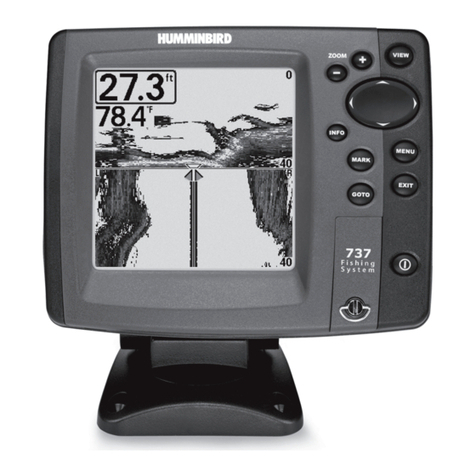
Humminbird
Humminbird 737 GPS Operation manual

Garmin
Garmin nüvi 2709 Series owner's manual

Garmin
Garmin GPSMAP 3205 - Marine GPS Receiver Declaration of conformity
Round Solutions
Round Solutions Nano Tracker Integration manual
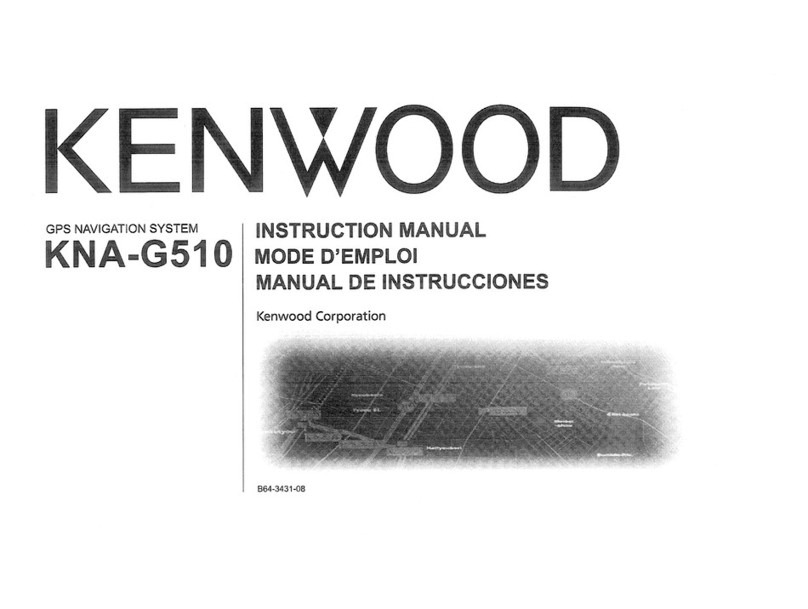
Kenwood
Kenwood KNA-G510 instruction manual
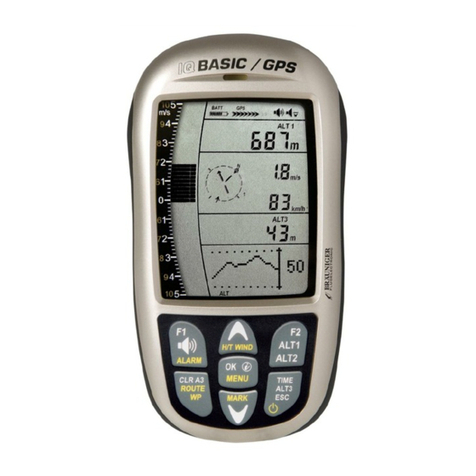
Brauniger
Brauniger IQ-BASIC-GPS Short form manual
